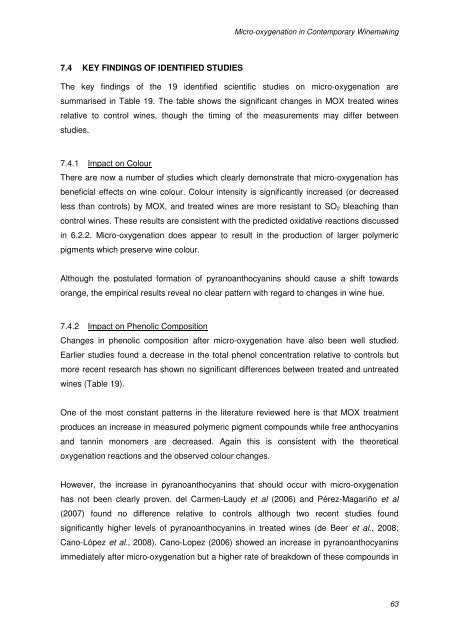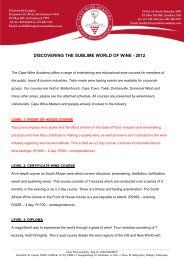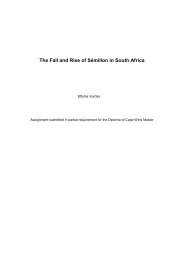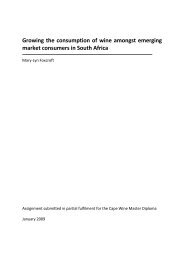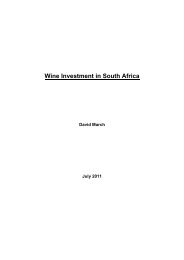micro-oxygenation in contemporary winemaking - Cape Wine ...
micro-oxygenation in contemporary winemaking - Cape Wine ...
micro-oxygenation in contemporary winemaking - Cape Wine ...
Create successful ePaper yourself
Turn your PDF publications into a flip-book with our unique Google optimized e-Paper software.
Micro-<strong>oxygenation</strong> <strong>in</strong> Contemporary W<strong>in</strong>emak<strong>in</strong>g7.4 KEY FINDINGS OF IDENTIFIED STUDIESThe key f<strong>in</strong>d<strong>in</strong>gs of the 19 identified scientific studies on <strong>micro</strong>-<strong>oxygenation</strong> aresummarised <strong>in</strong> Table 19. The table shows the significant changes <strong>in</strong> MOX treated w<strong>in</strong>esrelative to control w<strong>in</strong>es, though the tim<strong>in</strong>g of the measurements may differ betweenstudies.7.4.1 Impact on ColourThere are now a number of studies which clearly demonstrate that <strong>micro</strong>-<strong>oxygenation</strong> hasbeneficial effects on w<strong>in</strong>e colour. Colour <strong>in</strong>tensity is significantly <strong>in</strong>creased (or decreasedless than controls) by MOX, and treated w<strong>in</strong>es are more resistant to SO 2 bleach<strong>in</strong>g thancontrol w<strong>in</strong>es. These results are consistent with the predicted oxidative reactions discussed<strong>in</strong> 6.2.2. Micro-<strong>oxygenation</strong> does appear to result <strong>in</strong> the production of larger polymericpigments which preserve w<strong>in</strong>e colour.Although the postulated formation of pyranoanthocyan<strong>in</strong>s should cause a shift towardsorange, the empirical results reveal no clear pattern with regard to changes <strong>in</strong> w<strong>in</strong>e hue.7.4.2 Impact on Phenolic CompositionChanges <strong>in</strong> phenolic composition after <strong>micro</strong>-<strong>oxygenation</strong> have also been well studied.Earlier studies found a decrease <strong>in</strong> the total phenol concentration relative to controls butmore recent research has shown no significant differences between treated and untreatedw<strong>in</strong>es (Table 19).One of the most constant patterns <strong>in</strong> the literature reviewed here is that MOX treatmentproduces an <strong>in</strong>crease <strong>in</strong> measured polymeric pigment compounds while free anthocyan<strong>in</strong>sand tann<strong>in</strong> monomers are decreased. Aga<strong>in</strong> this is consistent with the theoretical<strong>oxygenation</strong> reactions and the observed colour changes.However, the <strong>in</strong>crease <strong>in</strong> pyranoanthocyan<strong>in</strong>s that should occur with <strong>micro</strong>-<strong>oxygenation</strong>has not been clearly proven. del Carmen-Laudy et al (2006) and Pérez-Magariño et al(2007) found no difference relative to controls although two recent studies foundsignificantly higher levels of pyranoanthocyan<strong>in</strong>s <strong>in</strong> treated w<strong>in</strong>es (de Beer et al., 2008;Cano-López et al., 2008). Cano-Lopez (2006) showed an <strong>in</strong>crease <strong>in</strong> pyranoanthocyan<strong>in</strong>simmediately after <strong>micro</strong>-<strong>oxygenation</strong> but a higher rate of breakdown of these compounds <strong>in</strong>63


